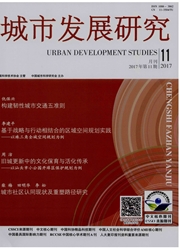

 中文摘要:
中文摘要:
随着城市不断向外蔓延,城乡结合部已成为城市地区的重要组成部分之一。城乡结合部在空间形成与演化方面表现出与传统城市,尤其中心城区较为显著的差异性。传统的城市空间研究视角与结论难以准确地解释中国城乡结合部空间的形成与演化机制。研究发现,基于居民经济社会特性的生产消费能力、社会网络结构与行为选择特征等对城乡结合部空间产生重要的影响,而这些空间效应一旦形成,又会反过来影响居民的经济行为选择,致使城乡结合部陷入不良发展的泥沼。鉴于此,城乡结合部的治理、改造应充分考虑居民经济行为特征与生产生活需求,并合理确定区域功能定位与发展方向,在促进城乡结合部空间优化的同时,实现城市和谐与品质提升。
 英文摘要:
英文摘要:
With the ongoing process of urban sprawl, rural-urban fringe has been one of the important parts of urban areas. There is great difference between rural-urban fringe and city proper in spatial formation and development, so traditional research perspectives and conclusions of urban space can't explain the developmental mechanism at rural-urban fringe accurately. Analysis showed that the production and consumption capacity, the structure of social network, and the characteristics of behavior selection of residents at rural- urban fringe have great effect on regional economic space, and once the spatial effects have formed, they influence the residents' economic behavior in return. As a result, rural-urban fringe falls into bad situations. Most of residents at rural-urban fringe are rejected by urban product and living system because of limited competitiveness. To survive, they have to be engage in low-level and nonstandard works, to keep to the low-cost consumption custom, and to live in a small and monotonous space. At the same time, bad living conditions, uncompleted support facilities, together with narrow and isolated living space restrict the social communication and cultural accomplishment of residents. Undoubtedly, if the living situation was not changed, the residents' economic behavior would not change, and the spatial effect would be continued. Therefore, the characteristics of residents' economic behavior and the demand of employment and life should be taken into account in the process of development and rebuilding of rural-urban fringe.
 同期刊论文项目
同期刊论文项目
 同项目期刊论文
同项目期刊论文
 期刊信息
期刊信息
